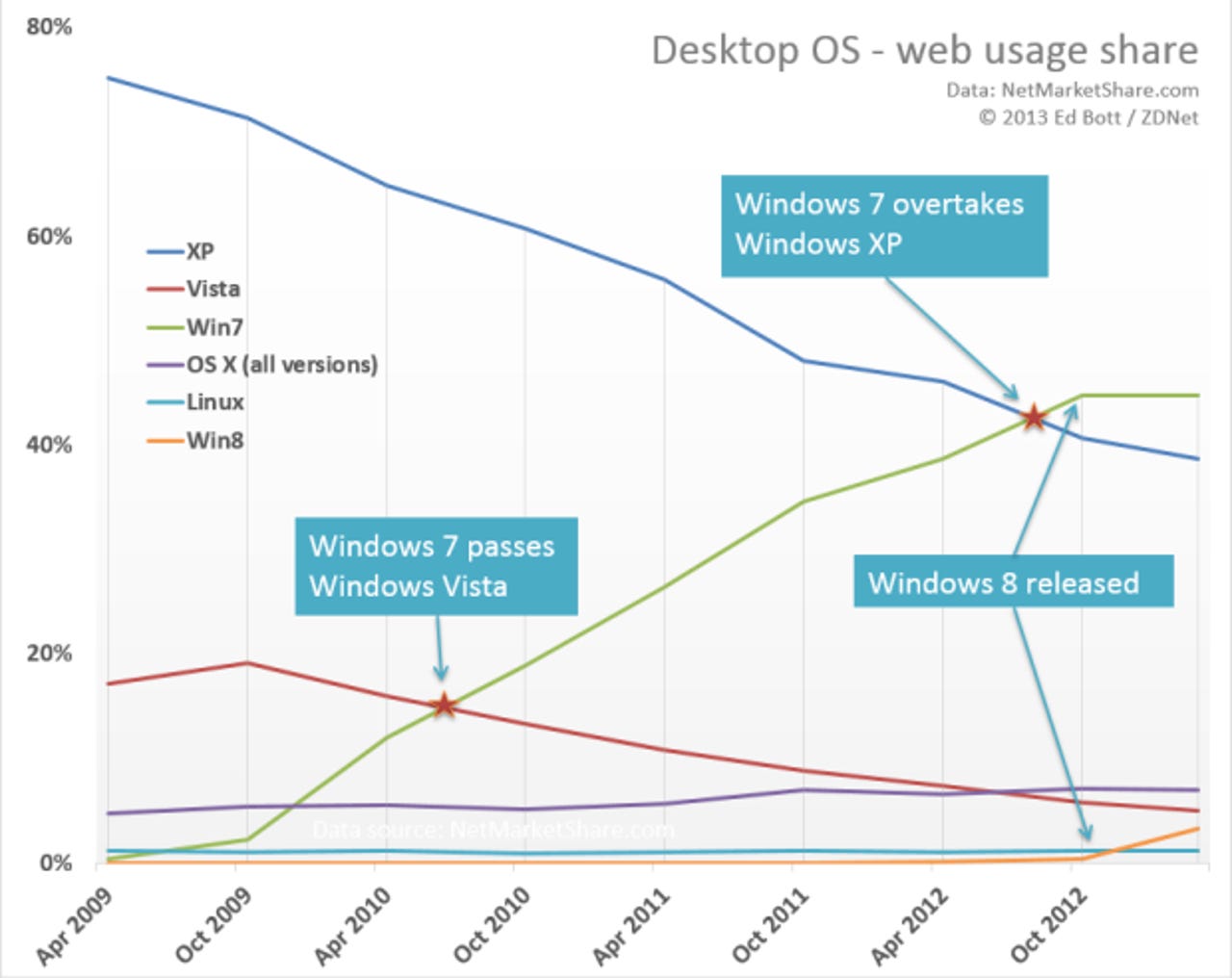Latest OS share data shows Windows still dominating in PCs

It’s the beginning of a new month, which means it’s time for a new batch of data from NetMarketShare on the usage share of desktop operating systems. Not coincidentally, that also means it’s time for the tech blogosphere to stare at the numbers for a few microseconds, deliver some snap judgments, and move on to the next shiny thing.
I prefer to dig a little deeper. Minor changes in monthly usage shares are mostly noise. It’s the trends that matter more. And because I’ve been collating these monthly figures at regular intervals for the past six years, I have that trend data close at hand, in handy graphical format.

The number that every other tech reporter will focus on today is the share for Windows 8. If you read that Windows 8’s share of usage is up to 3.17 percent, give that reporter a failing grade. The actual number is slightly higher, because you have to add in 0.12 percent for Windows 8 Touch and another 0.02 percent for Windows RT Touch (which NetMarketShare lumps into the Windows 8 bucket). At the current trajectory, Windows 8 is likely to pass 10 percent share by its first birthday this fall.
[Update: A note on those percentages. That 0.12 percent figure is presumably when NetMarketShare detected that a touch browser (Internet Explorer 10) was being used on Windows 8. That number shoiuld be compared to the total Windows 8 number of 3.17 percent. That means that roughly 4 percent of Windows 8 traffic is coming via touch, with an indeterminate amount of traffic coming via conventional desktop browsers on a touch-enabled Windows 8 PC. The actual percentage of touch-enabled PCs is therefore at least 4 percent and probably higher.]
How accurate is that 3.3 percent figure? Who knows? It could be off significantly in either direction, and any math one tries to do with these numbers is fuzzy at best. But taken at face value, with appropriately large error bars, that percent would be equal to about 50 million Windows 8 PCs in use in a world with an installed base of 1.5 billion PCs and Macs running Windows, desktop Linux, or OS X.
Here are my takeaways from the new data:
- Windows XP (38.73 percent) continues its steady decline, but its share of web usage is still remarkably high for a product that will reach its official end of life in just over a year.
- Windows Vista (4.99 percent) is nearly invisible, with a share that has finally (if barely) dropped below 5 percent. Despite its decline, Vista is still used more than any individual version of OS X.
- Windows 7 (44.73 percent) appears to have taken on the unofficial role as the Long-Term Support version of Windows, replacing XP. Note the green and blue lines that dominate this chart. Every other operating system, from Microsoft or its rivals, is in the sub-10 percent range, making them experimental, transitional, or part of a market niche. Of the entries on that chart, Windows 8 is the only one that I expect to break through the 10 percent barrier, and even at that Windows 8 might turn out to be transitional.
- Windows 8 (3.31 percent) is slowly (very slowly) gaining traction. It’s worth noting that Windows 7’s steady increase in usage flatlined as soon as Windows 8 was released.
On traditional PCs and Macs, Microsoft still owns an overwhelming market share, with 91.8 percent of all traffic coming from Windows-based machines. Among non-Microsoft operating systems, both OS X and Linux have stalled since October 2011, hovering around 6.9 percent and 1.2 percent, respectively.
With the general decline of the PC market, that could just mean that Apple has focused more of its energy on mobile devices (which are not included in these numbers). In my personal stats, I've noticed that nearly 20 percent of all traffic over the past few months has been from mobile devices, and that percentage continues to grow.
In looking at the numbers, I noticed one trend you probably won’t see discussed elsewhere. Pundits obsess over upgrade rates for Microsoft Windows versions, but they almost never mention OS X. So here are a few Mac facts to chew on:
- Despite its $19.99 price tag, only 38.3 percent of all Mac users are running the most recent OS X release, Mountain Lion, which was released eight months ago. Most of those were included with new Macs.
- More Mac users are running the 2009 Snow Leopard (27 percent of Mac users) than the 2011 Lion (26.2 percent).
- Surprisingly, 35.5 percent of all Mac users are running versions of OS X that are officially unsupported by Apple. That places them at a higher risk of contracting malware delivered through flaws in the Java browser plugin, which was shipped with every version of OS X until Snow Leopard.
Oh, and one more interesting fact worth passing along. One widely discussed operating system isn’t visible in the NetMarketShare numbers. There’s no entry for Chrome OS at all. A spokesperson for the company tells me those numbers will be included in an update to their tracking stats, coming soon.
Net Market Share publishes snapshots of PC usage based on data from 160 million visits per month to its large collection of sites (the exact methodology is here). Its monthly reports on operating system versions contain a wealth of detailed information about even the most obscure OSes. Their stats for mobile platforms are tracked separately.